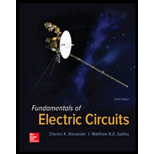
Find the expression of current
Answer to Problem 7P
The expression of current
Explanation of Solution
Given data:
The step response of an
The value of initial current
The value of
Calculation:
Apply Laplace transform for equation (1) with initial conditions.
Simplify the above equation as follows.
Substitute
Simplify the above equation to find
From equation (3), the characteristic equation is written as follows,
Write an expression to calculate the roots of characteristic equation
Here,
Compare equation (4) with quadratic equation
Substitute
Now, the equation (3) is written as follows.
Take partial fraction for equation (6).
The equation (7) can be written as follows.
Simplify the above equation.
Substitute
Simplify the above equation.
Simplify the above equation to find
Substitute
Simplify the above equation as follows.
Simplify the above equation to find
Multiply and divide by
Simplify the above equation to find
Substitute
Simplify the above equation as follows.
Simplify the above equation to find
Multiply and divide by
Simplify the above equation to find
Substitute
Apply inverse Laplace transform for equation (9) to find
Simplify the above equation as follows.
Simplify the above equation as follows.
Conclusion:
Thus, the expression of current
Want to see more full solutions like this?
Chapter 16 Solutions
Fundamentals of Electric Circuits
- (use integration) +) [v (t) - U (+-1)] * 8 (+-1) Convolve Please be easier output. plots when solving understand. Draw the plot also snow to for it of to thearrow_forwardThe particular integral of the differential equation (D+7)(D – 7)y = sec²x – tan²x is. 1 7 -1 49 1 49 –1 14arrow_forwardThe following DT signal x(n) = u(n+2)-u(n-2) is %3D Causal Static Non-Causal O Anti-Causalarrow_forward
- For a certain electrical circuit the applicable differential equation is 100(d2i/dt2) + 200(di/dt)+ (i/0.005) =0, with initial conditions i(0)=0 and i'(0)=1 determine the unique solution for the current i in terms of the time tarrow_forwardFind V(t) for t>0 in the circuit below t=0 swi R1 4 ka 1A C1 5 uF R2 6 ka Vt)arrow_forwardB) For the following block diagram, find the step R(s) 100 C(s) s(s+2) response: 0.1s+1arrow_forward
- Consider the circuit below with v(t) = 150 sin(70t) mV for t> 0 and v(t) = 0 for t<0. C1= 100 uF, C2 = 300 uF, C3 = 400 uF, and C4 = 200 uF v(t) Fa C1 C2 C3 C4 Question 6: What is the expression for the current flowing through capacitor C2? (Be sure to enter an answer here and show your calculations in detail on your paarrow_forwardIn the step 2 they exapand the summation and say that u(t-3), u(t-6) and u(t-9) are out of range. Why? In the exercise it says that t is [0,3]arrow_forwardFind the relationship between the output v. (t) and inputs v, (t) and v, (t). R5 C R4 V2 0- R2 Vo v1 R1 R3arrow_forward
- A series RLC circuit is described by d²i di dt² L i +R + dt с = 2 Find the response when L = 0.5H, R = 492, and C = 0.2 F. Let i(0) = 1, di(0)/dt = 0.arrow_forwardFor the circuit below, find s-domain circuit, and vi(t) and v2(t). 50 kN b/ 1.25 mH 10 μF 450 V v$ 25 N 24 µF 16 μF7arrow_forwardThe switch in figure below is in zero state when the step function input is applied. R=15OK, L=0.5H, C= 250nF and Va = 70V. Find Vc(t) and IL(t) for t 2 0. R1 Va L1arrow_forward
 Introductory Circuit Analysis (13th Edition)Electrical EngineeringISBN:9780133923605Author:Robert L. BoylestadPublisher:PEARSON
Introductory Circuit Analysis (13th Edition)Electrical EngineeringISBN:9780133923605Author:Robert L. BoylestadPublisher:PEARSON Delmar's Standard Textbook Of ElectricityElectrical EngineeringISBN:9781337900348Author:Stephen L. HermanPublisher:Cengage Learning
Delmar's Standard Textbook Of ElectricityElectrical EngineeringISBN:9781337900348Author:Stephen L. HermanPublisher:Cengage Learning Programmable Logic ControllersElectrical EngineeringISBN:9780073373843Author:Frank D. PetruzellaPublisher:McGraw-Hill Education
Programmable Logic ControllersElectrical EngineeringISBN:9780073373843Author:Frank D. PetruzellaPublisher:McGraw-Hill Education Fundamentals of Electric CircuitsElectrical EngineeringISBN:9780078028229Author:Charles K Alexander, Matthew SadikuPublisher:McGraw-Hill Education
Fundamentals of Electric CircuitsElectrical EngineeringISBN:9780078028229Author:Charles K Alexander, Matthew SadikuPublisher:McGraw-Hill Education Electric Circuits. (11th Edition)Electrical EngineeringISBN:9780134746968Author:James W. Nilsson, Susan RiedelPublisher:PEARSON
Electric Circuits. (11th Edition)Electrical EngineeringISBN:9780134746968Author:James W. Nilsson, Susan RiedelPublisher:PEARSON Engineering ElectromagneticsElectrical EngineeringISBN:9780078028151Author:Hayt, William H. (william Hart), Jr, BUCK, John A.Publisher:Mcgraw-hill Education,
Engineering ElectromagneticsElectrical EngineeringISBN:9780078028151Author:Hayt, William H. (william Hart), Jr, BUCK, John A.Publisher:Mcgraw-hill Education,





